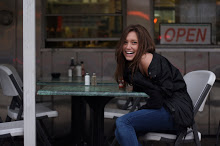 A few weeks ago Seth introduced me to the work of Austrian artist Erwin Wurm, whose Fat Convertible (2005) has been on my mind ever since. Wurm made a series of "fat cars," by essentially stuffing existing cars with styrofoam and fiberglass, thereby turning the sporty vehicles into comical, cartoonish (art) objects. In keeping with the current fad, Wurm is asking us to consider the connections between power, wealth, consumption, health, obesity, and perhaps the ways advertising affects each of these entities, and how art plays a role. As I see it, the most obvious of the many messages here is: when we lack the ability to practice restraint, we become useless. (Think Pixar's Wall-E.)
A few weeks ago Seth introduced me to the work of Austrian artist Erwin Wurm, whose Fat Convertible (2005) has been on my mind ever since. Wurm made a series of "fat cars," by essentially stuffing existing cars with styrofoam and fiberglass, thereby turning the sporty vehicles into comical, cartoonish (art) objects. In keeping with the current fad, Wurm is asking us to consider the connections between power, wealth, consumption, health, obesity, and perhaps the ways advertising affects each of these entities, and how art plays a role. As I see it, the most obvious of the many messages here is: when we lack the ability to practice restraint, we become useless. (Think Pixar's Wall-E.)Something about Wurm's work seemed extremely familiar to me, though I had never seen it before. Perhaps most obviously, Wurm’s critique and celebration of consumerism and the values of contemporary society keeps with the tradition of Pop art from the 50's through the present.

Yet, after some thought about Wurm’s work, I realized that in terms of style, and perhaps message as well, Wurm's “fat series,” (he’s also made a fat house, etc,) is quite similar to Claes Oldenburg's The Store (1961). The Store was a storefront on NYC’s Lower East Side, which Oldenburg opened from December 1961 to January 1962, for the purpose of emphasizing the connections between art, commodity, and commerce. At The Store, Oldenburg created and sold food and household items, thereby elevating everyday goods to the status of art objects. It is also possible to analyze Wurm’s work through that lens, as of his early works, Wurm said, “I am interested in the object, in liberating it from its field, giving it a new validity and meaning. It is integrated in a different system of values and ideas: in that of art. In this way it loses its function and takes on another.” (Erwin Wurm interviewed by Desirée Schellerer for Design Vienna.) Whether or not you can see the similarity between the messages of the two artists, in terms of physicality, it is quite obvious that Wurm’s fat works are “high-tech” versions of Oldenburg’s swollen, glistening everyday, turned art objects.

On a more basic, or superficial level, the title of Wurm's work is eerily evocative of Joseph Beuys' creepy work. Beuys’ works are too disturbing to delve into in this lighthearted post, but in the 1960’s Beuys created a “fat series” of his own. To the right you can see Beuys’ Fat Battery (1963). Though extremely different in terms of physical appearance and message, I have to wonder if Wurm was deliberately channeling Beuys when naming his work. (Sorry for the rather cryptic and probably curiosity sparking nature of this paragraph, I promise a detailed post on Beuys is coming soon…)
So, funny and alluring as Wurm's "fat series” is, it just might not the most original group of artworks ever, but don't worry, the “fat series” is not all that Wurm has produced. If you want to see some crazy, cutting edge Wurm work, check out his House Attack (2006), an instillation that he implanted on the facade of Vienna's Museum Moderner Kunst (MUMOK). Of the work, Edelbert Kob, curator of MUMOK, said “House Attack is… A symbol for conservative, small-minded longings, the single-family house collides into the museum as a temple to the muses, and the museum itself now also becomes part of the sculpture. House Attack confuses our perception of art and everyday reality…”


While I can't imagine putting a "fat Ferrari" in my living room at any point in my life, I find I am attracted to such pieces. While I am sure Wurm's goal was to create that attraction, I still find it interesting how when one is told something is "art" one's reaction can be 180 degrees different from when one believes they are viewing "life." But as I think now, perhaps I am mistaken. I find my attraction to the piece to be of a comic nature, as I smile now thinking of the "fat Ferrari," which may be the most appropriate approach to life. If art is funny, how can my reaction to life not be? As Oscar Wilde said, "Life imitates art far more than art imitates Life."
ReplyDelete